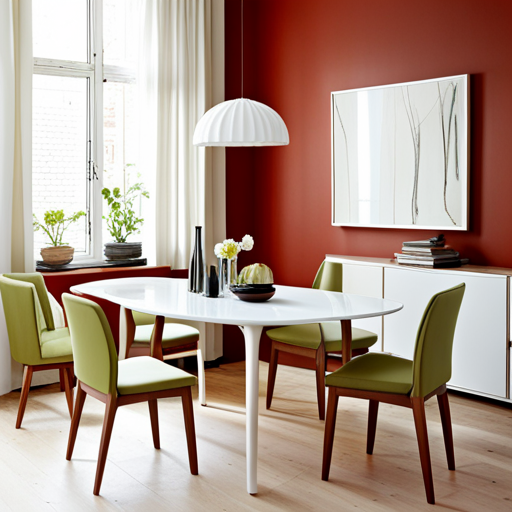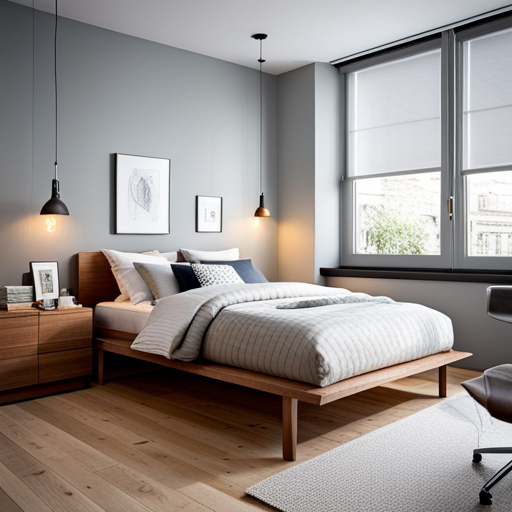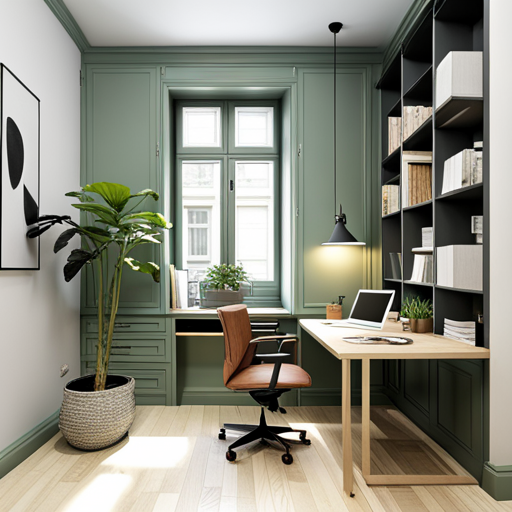Decorating a small room can be challenging, but with the right techniques, you can create an illusion of a larger room. In this article, we will explore some practical tips and tricks to make your small room appear more spacious and inviting.

Designed by Jipsē Co Studio designer Sara K.
Living in a small space can present unique challenges, but it also offers opportunities for creativity and problem-solving. Limited square footage encourages you to think outside the box and find innovative ways to maximize the available space. It forces you to be intentional with your design choices, carefully selecting furniture and decor items that truly enhance the space.
One of the valuable lessons that small living spaces teach is the importance of organization and efficient storage solutions. With limited room to spare, you develop practical skills in decluttering and maintaining a tidy home. Every item must have a designated place, and clever storage solutions become essential.
Working with a small space allows you to experiment with different layout options and furniture arrangements. You gain an understanding of how spatial planning impacts functionality and flow. By finding the most efficient and visually pleasing arrangement, you can make the most of the available space.

Designed by Jipsē Co Studio designer Sara K.
Designing a small space requires attention to detail and a keen eye for scale and proportion. You learn to carefully consider the size and placement of furniture and decor items to create a harmonious and visually balanced environment. This attention to detail helps develop a strong sense of aesthetics.
Living in a small space can also teach you to appreciate the value of simplicity and minimalism. With limited room, you learn to prioritize what truly matters and avoid unnecessary clutter. This minimalist approach can create a sense of calm and tranquility in your living space.
Despite the challenges, small living spaces can foster a sense of coziness and intimacy. With careful design choices, you can create a warm and inviting atmosphere that encourages creativity and relaxation. The satisfaction of successfully transforming a limited area into a functional and visually appealing living environment can bring a sense of accomplishment and pride.
Keep Reading For Some Helpful Decorating Tips:

Light and Bright Colors:
Opt for light and neutral colors on your walls, ceiling, and floor. Light colors reflect more natural light, making the room feel airy and open. Avoid dark or bold colors as they tend to absorb light and make the space feel smaller.
Here are some examples:
- Choose furniture and accessories in light or neutral colors to keep the room feeling open and airy.
- Opt for sheer or light-colored curtains to allow natural light to filter in and make the room appear larger.
- Enhance your visual aesthetic with a monochromatic color scheme, utilizing varying shades of a single color. This approach creates a cohesive and visually expansive look, ultimately elevating the overall design.
- Keep the floor light-colored, either with a light-colored rug or hardwood floors, to further enhance the sense of space.
- Consider using light-colored or translucent furniture pieces to create a sense of transparency and openness.
Utilize Mirrors:
Mirrors are a fantastic tool to create an illusion of space. Place a large mirror on one of the walls to reflect light and give the impression of a larger room. In fact, you can also use mirrored furniture or decorative mirrors strategically to enhance the effect.
Here are some examples:
- Place a large mirror on a wall opposite a window to reflect natural light and create the illusion of a larger space.
- Use multiple mirrors in different sizes and shapes to add visual interest and create the perception of depth.
- Hang a mirror behind a piece of furniture, such as a console table or a sofa, to give the impression of an extended space.
- Install a floor-to-ceiling mirror or a mirrored wall to visually expand the height of the room.
- Position a mirror near a light source, such as a lamp or a chandelier, to amplify the brightness and make the room feel more spacious.
Strategic Furniture Placement:
Consider the layout of your furniture to maximize the available space. Place larger furniture pieces against the walls to create an open flow in the center of the room. Avoid blocking windows or doorways, as this can make the room feel cramped.
Here are some examples:
- Identify the focal point of the room, such as a window or a fireplace, and arrange your furniture around it. This helps create a visually appealing and balanced layout.
- Divide the room into different zones based on their functions, such as a seating area, a workspace, or a dining area. Use rugs, bookshelves, or curtains to visually separate these zones.
- Make use of vertical space by installing wall-mounted shelves or hanging storage units. This helps free up floor space and keeps the room organized.
- Place furniture pieces along the walls to create an open flow and maximize the central space. This can help create an illusion of a larger room.
Multi-Functional Furniture:
When living in a small space, it is important to invest in multi-functional pieces of furniture that can serve multiple purposes. Consider items such as bench storage, bunk beds, and built-in cabinets. These pieces can help save you space while also adding visual interest to the room.
Here are some examples:
- Use a folding dining table or a drop-leaf table that can be expanded or collapsed based on your needs.
- Consider a wall-mounted desk that can be folded up when not in use to save space.
- Utilize a storage bed with built-in drawers or shelves to maximize storage space in a small bedroom.
- Use a bookshelf that can also act as a room divider to create separate zones within the room.
- Incorporate nesting tables or stackable stools that can be easily stored away when not in use.
- Consider a convertible sofa or futon that can be transformed into a bed for guests.
Use a storage ottoman or bench that can also serve as extra seating while providing hidden storage space.
Optimize Natural Light:
To enhance the amount of natural light in a room, it’s important to keep windows free from heavy curtains or blinds. Instead, consider choosing sheer or light-colored window treatments that allow soft sunlight to filter through. Not only does natural light brighten up the space, but it also creates an open and inviting atmosphere.
Here are some examples:
- Use sheer or light-colored curtains or blinds that can be easily opened or pulled back to let in as much light as possible.
- Avoid heavy or dark window treatments that can block or absorb natural light.
- Place mirrors strategically across from windows to reflect and amplify natural light throughout the room.
- Use light-colored or reflective surfaces, such as glossy paint or shiny materials, on walls, floors, and furniture to bounce and distribute natural light.
Declutter and Organize:
A cluttered room can feel cramped and overwhelming. Keep your small space tidy and organized by decluttering regularly. Invest in smart storage solutions like floating shelves, under-bed storage, or multi-functional furniture to maximize storage without sacrificing floor space.
Here are some examples:
- Start by getting rid of any unnecessary items or belongings that you no longer need or use. This will help create more space and make organizing easier.
- Maximize your use of vertical space by installing shelves, wall-mounted organizers, or hanging storage solutions. These clever storage solutions not only keep your items off the floor but also free up floor space, making your living area more organized and spacious.
- Utilize the space under your bed by using storage containers or bins to store items like extra bedding, seasonal clothing, or shoes.
- Organize your closet efficiently by using closet organizers, hanging shelves, or storage bins. This helps maximize the available space and keeps your belongings neatly arranged.
Use Vertical Space:
When space is limited, maximize the use of vertical space. Incorporate tall bookshelves or wall-mounted storage units to elevate belongings off the floor. This not only expands storage options but also directs the gaze upward, creating an illusion of heightened room dimensions.
- Install wall-mounted shelves to store books, decorative items, or everyday essentials. This helps free up floor space and adds storage without taking up valuable square footage.
- Utilize floating shelves to display plants, artwork, or small decor items. These shelves create visual interest while maximizing vertical space.
- Invest in tall bookcases or cabinets that reach the ceiling. This allows you to store items vertically and take advantage of the entire height of the room.
- Use hanging organizers or hooks on the walls or doors to store items like bags, hats, or accessories. This keeps them off the floor and utilizes vertical space effectively.
- Install overhead storage units or racks to store items that are not frequently used, such as seasonal clothing or luggage. This keeps them out of the way while utilizing the vertical space.
Choose the Right Lighting:
Proper lighting can significantly impact the perception of space. Incorporate a combination of ambient, task, and accent lighting to create a layered effect. Use adjustable lighting fixtures to highlight specific areas and create depth in the room.
Here are some examples:
- Use overhead or recessed lighting to provide overall illumination and create a warm and inviting atmosphere in the room.
- Incorporate task lighting, such as desk lamps or under-cabinet lights, to provide focused illumination for specific activities like reading, studying, or working.
- Install accent lights, such as wall sconces or picture lights, to highlight artwork, architectural features, or decorative elements in the room.
- Place mirrors strategically to reflect natural light or artificial light sources, making the room appear larger and brighter.
Opt for Minimalist Home Furnishings:
In a small room, less is more. Avoid cluttering the space with too many decorative items. Instead, opt for a minimalist approach with a few carefully chosen pieces. This will create a clean and uncluttered look, making the room feel more spacious.
Here are some examples:
- Furniture with simple designs that don’t have too many details or embellishments.
- Choose muted colors and subtle textures to keep the room from looking overly busy.
- Opt for accent pieces like modern wall art or framed photographs, rather than bulky sculptures or ornate decorative items.
With these practical tips, you can transform your small room into a visually larger and more inviting space. Remember, the key is to create an illusion of openness by using light colors, strategic furniture placement, mirrors, and optimizing natural light. By decluttering, utilizing vertical space, and incorporating the right lighting, you can make the most of your small room and enjoy a more spacious living environment.
